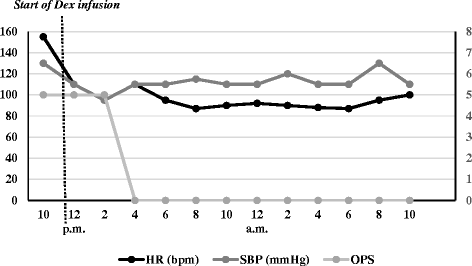A cannabinoid-intoxicated child treated with dexmedetomidine: a case report
- PMID: 26138711
- PMCID: PMC4490763
- DOI: 10.1186/s13256-015-0636-2
A cannabinoid-intoxicated child treated with dexmedetomidine: a case report
Abstract
Introduction: In the last 20 years, the rate of exposure to marijuana has increased dramatically, even in the pediatric population. Effects of intoxication are variable, more severe neurological symptoms can be observed following ingestion, thus hospital or intensive care unit admission is often required. Usually cannabinoids intoxicated patients are treated with administration of benzodiazepines or opioids, accepting the related risk of intubation and mechanical ventilation. Dexmedetomidine is a highly selective α2-adrenergic receptor agonist, with no effect on the respiratory drive and pattern and produces a good level of sedation, allowing to avoid the administration of other sedatives. To our knowledge, this is the first reported case of dexmedetomidine use to support a cannabis intoxicated patient.
Case presentation: A 19-month-old Caucasian boy was presented to our emergency department. At the time of his arrival, he was somnolent with paroxysms of agitation, breathing spontaneously and hemodynamically stable. The results of all investigations were negative, but the result of the immunochemical screening of his urine was positive for Δ(9)-tetrahydrocannabinol. The patient was admitted to the pediatric intensive care unit and treated with a continuous infusion of dexmedetomidine.
Conclusions: Dexmedetomidine is a fairly safe and effective antidote for pediatric marijuana or natural cannabinoid exposures. Its properties and potential to allow for "cooperative" sedation make it a more attractive choice with fewer side effects than benzodiazepines or opioids.
Figures

Similar articles
-
Dexmedetomidine infusion as adjunctive therapy to benzodiazepines for acute alcohol withdrawal.Ann Pharmacother. 2008 Nov;42(11):1703-5. doi: 10.1345/aph.1K678. Epub 2008 Sep 9. Ann Pharmacother. 2008. PMID: 18780809
-
Additional experience with dexmedetomidine in pediatric patients.South Med J. 2003 Sep;96(9):871-5. doi: 10.1097/01.SMJ.0000053557.75799.09. South Med J. 2003. PMID: 14513982 Review.
-
Successful use of dexmedetomidine for sedation in a 24-week gestational age neonate.Ann Pharmacother. 2009 Oct;43(10):1707-13. doi: 10.1345/aph.1M245. Epub 2009 Sep 15. Ann Pharmacother. 2009. PMID: 19755621
-
Dexmedetomidine: a review of clinical applications.Curr Opin Anaesthesiol. 2008 Aug;21(4):457-61. doi: 10.1097/ACO.0b013e328305e3ef. Curr Opin Anaesthesiol. 2008. PMID: 18660652 Review.
-
Dexmedetomidine (Precedex) for ICU sedation.Med Lett Drugs Ther. 2011 May 30;53(1365):41-2. Med Lett Drugs Ther. 2011. PMID: 21617592
Cited by
-
Dexmedetomidine to Treat 3, 4-Methylenedioxymethamphetamine-Induced Agitation in a 13-Month-Old Infant: A Case Report and Literature Review.J Pediatr Intensive Care. 2019 Sep;8(3):175-177. doi: 10.1055/s-0039-1677815. Epub 2019 Feb 13. J Pediatr Intensive Care. 2019. PMID: 31404223 Free PMC article.
-
Marijuana use in children: An update focusing on pediatric tetrahydrocannabinol and cannabidiol use.J Am Coll Emerg Physicians Open. 2022 Jul 5;3(4):e12770. doi: 10.1002/emp2.12770. eCollection 2022 Aug. J Am Coll Emerg Physicians Open. 2022. PMID: 35813522 Free PMC article.
-
The perils of recreational marijuana use: relationships with mental health among emergency department patients.J Am Coll Emerg Physicians Open. 2020 Mar 8;1(3):281-286. doi: 10.1002/emp2.12025. eCollection 2020 Jun. J Am Coll Emerg Physicians Open. 2020. PMID: 33000044 Free PMC article.
-
Dexmedetomidine for Treatment of Delayed Peak Symptoms of Cannabis Withdrawal Syndrome: A Case Report.Hosp Pharm. 2021 Oct;56(5):462-465. doi: 10.1177/0018578720919025. Epub 2020 May 13. Hosp Pharm. 2021. PMID: 34720146 Free PMC article.
-
Plant toxins and acute medicinal plant poisoning in children: A systematic literature review.J Res Med Sci. 2018 Mar 27;23:26. doi: 10.4103/jrms.JRMS_629_17. eCollection 2018. J Res Med Sci. 2018. PMID: 29692823 Free PMC article. Review.
References
-
- Croche Santander B, Alonso Salas MT, Loscertales Abril M. [Accidental cannabis poisoning in children: report of four cases in a tertiary care center from southern Spain] Arch Argent Pediatr. 2011;109:4–7. - PubMed
-
- American Academy of Pediatrics Committee on Drugs Effects of marihuana on man. Pediatrics. 1975;56:134–43. - PubMed
Publication types
MeSH terms
Substances
LinkOut - more resources
Full Text Sources
Other Literature Sources

